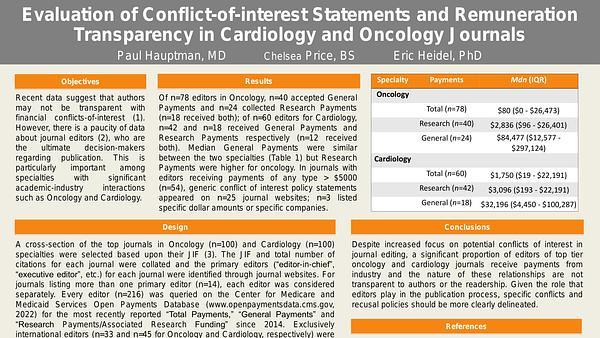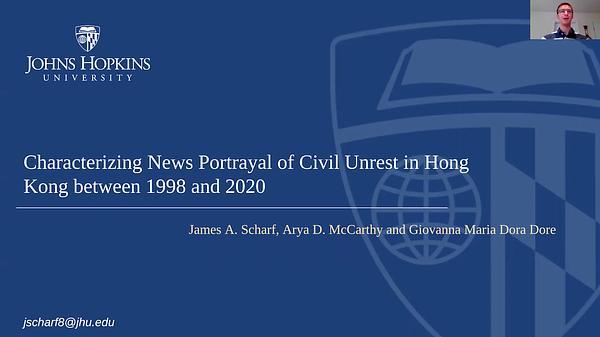Would you like to see your presentation here, made available to a global audience of researchers?
Add your own presentation or have us affordably record your next conference.
keywords:
conflict of interest
funding/sponsorship
Objective Commercial companies often fund randomized clinical trials, and methodological studies suggest that this funding may influence trial results and conclusions.1 However, such methodological studies are often at risk of confounding given that they compare trials that differ for reasons other than funding source. The risk of confounding can be minimized in meta-epidemiological studies that compare similar trials within meta-analyses. The Commercial Funding in Trials (COMFIT) study was initiated based on a consortium of researchers who shared data sets with information on meta-analyses and trials included in meta- epidemiological studies (details available in the protocol2). The primary aim of COMFIT was to investigate the impact of commercial funding on estimated intervention effects in randomized clinical trials.
Design The study approach was to identify meta- epidemiological studies and combine and reanalyze their meta-analysis and trial data. Studies with data on trial funding source and results were included (eg, primarily by investigating funding source or investigating a different trial characteristic and adjusting for funding source). Five bibliographic databases and other sources (eg, conference proceedings) were searched. Meta-epidemiological study authors were contacted and invited to join the COMFIT consortium and share their unpublished data. Construction of the COMFIT database involved, for example, merging data from included studies and checking data quality. Noninformative meta-analyses (eg, meta-analyses in which all trials had the same funding type) and overlapping or correlated meta-analyses and trials (eg, multiple meta- analyses included from the same systematic review) were removed. Bayesian hierarchical models were used to estimate the ratio of odds ratios (RORs) and heterogeneity statistics (to describe within- and between-study heterogeneity). A ROR <1 indicated exaggerated intervention effects in trials with commercial funding. Unadjusted and adjusted analyses using bias domains (low vs high risk of bias from sequence generation, allocation concealment, blinding, incomplete outcome data, selective reporting, and overall risk of bias) and trial sample size were performed. Subgroup and sensitivity analyses (eg, using the Sterne 2-step approach3) were performed.
Results The COMFIT database contained data on 554 meta-analyses, with 4936 trials from 17 meta-epidemiological studies. Meta-analyses included a median (range) of 7 (2-68) trials. In total, 1368 trials (28%) had noncommercial funding, 1840 trials (37%) had sole commercial or mixed commercial and noncommercial funding, and the remaining 1728 trials (35%) did not have funding sources reported. Using data from the largest meta-epidemiological study (20% of meta- analyses, 19% of trials), the ROR for the association between commercial funding and estimated intervention effects was 0.90 (95% CI, 0.84-0.96) (preliminary findings, not the primary analysis).
Conclusions The COMFIT database may enable comprehensive analyses of the impact of commercial funding on trial results. The primary analyses will have a markedly increased statistical power and reduced risk of confounding and reporting bias compared with previous studies.
References
Lundh A, Lexchin J, Mintzes B, Schroll JB, Bero L. Industry sponsorship and research outcome. Cochrane Database Syst Rev. 2017;2:MR000033. doi:10.1002/14651858.MR000033. pub3
Nejstgaard CH, Lundh A, Abdi S, et al. Combining meta- epidemiological study datasets on commercial funding of randomised clinical trials: database, methods, and descriptive results of the COMFIT study. Res Synth Methods. 2022;13(2):214-228. doi:10.1002/jrsm.1527
Sterne JAC, Jüni P, Schulz KF, Altman DG, Bartlett C, Egger M. Statistical methods for assessing the influence of study characteristics on treatment effects in “meta- epidemiological” research. Stat Med. 2002;21:1513-1524.
Conflict of Interest Disclosures Asbjørn Hróbjartsson and Andreas Lundh are currently members of the TACIT steering group to develop a tool for addressing conflicts of interest in trials. Toshi A. Furukawa reported receiving grants and personal fees from Mitsubishi-Tanabe and Shionogi, receiving personal fees from Sony outside the submitted work, and having patent 2020-548587 concerning smartphone cognitive behavioral applications pending and intellectual properties for the Kokoro application licensed to Mitsubishi-Tanabe. Jelena Savović was paid by Core Models to deliver an online teaching session of basic evidence synthesis methods. John P. A. Ioannidis is co-director and Isabelle Boutron is an advisory board member of the Peer Review Congress, but they were not involved in the review or decision for this abstract.


